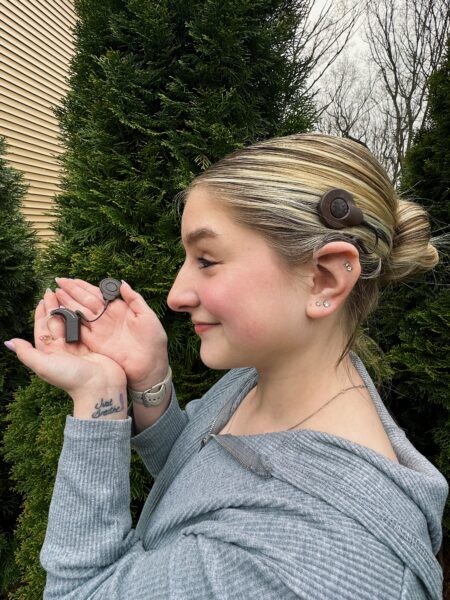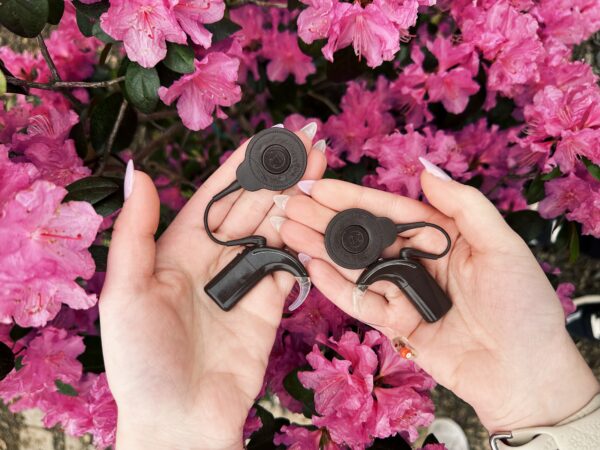Samantha experienced hearing loss as a result of an infection caused by cystic fibrosis. This eventually led to her receiving a cochlear implant. This story details her experience transitioning to bilateral cochlear implants. Read on to learn about hear ability to hear in both ears and all the things in her life she has been able to enjoy because of her cochlear implants:
“’Trust the process’ is what cochlear implant recipients are often told from the beginning to end of the surgical, activation and hearing adjustment process. If I had to sum up my experience of becoming a bilateral cochlear implant recipient in just a few words, those words would be ‘trust the process.’
How my journey to cochlear implants started
I had been a fully natural-hearing individual for the first 20 years of my life, until cystic fibrosis related antibiotics took my hearing in an attempt to improve the state of my lung health that was compromised due to an infection. For my entire life up until that point, hearing naturally in both my ears was all I ever knew. When I received my first cochlear implant, I began to feel more in control of my life. I was able to hear in one ear again. It was different, but the sounds I needed to re-learn were better than sounds I would never hear again.
The decision to be implanted on my other side was a mindless one at the moment. I knew the possibility was eventually going to be presented to me, and somewhere deep inside, ‘yes’ felt like the correct answer for me and my life. In the time leading up to my second cochlear implant surgery, I went through a roller coaster of emotions. Anticipation became my best friend and my worst enemy.
Some days, I woke up excited about the possibility of getting my hearing back in both ears. I felt excited about getting back to a sense of normal and experiencing the world through both ears. Other days, I woke up frightened; I woke up with this looming feeling that I was going to forget what things sounded like in my natural hearing state. I felt like I was closing a chapter of my life that was supposed to remain open until my old age. I spent many nights crying, staring into emptiness, questioning the decision I was making. I walked into surgery that day, still being split down the middle about how my life was going to change being a bilateral recipient.
Realities of bilateral cochlear implants
The next time I walked into the audiologist’s office to get my sound processor activated, my attitude remained the same. I had just turned 22 years old1 and was indifferent about the journey to come. The following days were a mix of trying not to laugh at serious conversations where people sounded like the Terminator and getting so frustrated that I would take my sound processor off and refuse to put it back on.
I remember coming home to my boyfriend one night, in tears because I couldn’t recognize the voice that I loved and the voice that I could pick out from anywhere- his. When I went looking for support from family, friends and my audiologist, I’ll give you one guess what they told me: ‘trust the process.’
Sitting here today, trusting the process, was the best decision that I could have made.
Have you ever had one of those moments where you realized all the blood, sweat and tears were worth it? I came home from work one day, and I was standing in my kitchen when I realized from downstairs that I could hear that the upstairs shower was running. Previously, I had walked through the bathroom without realizing the shower was still running and here I was, a floor away, being able to hear that it was on.
Being able to take control of my life
Following my first cochlear implant, I felt like I had my life back, but now I can truly say that I have my life back in my control. Wearing two cochlear implants has allowed me to live a hearing life like the one that I remember from before losing my natural hearing. I was worried that being bilateral would make me forget; however, it made me remember.
I can listen to music2 and understand the language. I can listen to the voices of the people I love and know who they are – I can even pick their voices out of a crowd. I am able to hear the birds outside on a beautiful day. I no longer feel like I am living a life that is just passing me by; I am able to be present.
I was able to fall back in love with the beauty of life and the people that I was surrounded by. I used to be fearful of the part of me that was lost and the people I would meet after losing my hearing. I feared that they would never know the real me and the hearing version of myself. I can’t put into words what it has felt like getting that part of me back.
Having fun as I look towards the future
Cochlear implants have guided me out of the darkest time in my life and have allowed me to get back to living a life that I am excited by and can be proud of. It took time, hard work and the support of the people that I love the most, but I am here today hearing the way I did before hearing loss.
I am now a graduate student in a counselor training program, preparing to enter the workforce with client work. I truly cannot imagine stepping into this role without my sound processors and Mini Microphone 2+, which will allow me to hear and understand my future clients. I see the benefit of my cochlear implants every day, both professionally and personally.
If I could tell myself anything during that initial adjustment stage, it would be to trust the process, give myself grace and know that all the apprehension, fear and sadness are going to lead to a life better than you ever could have imagined for yourself.
And if you ever need a cool party trick, answering the phone via the Bluetooth® using the direct streaming** features with sound processors always gets a great reaction!”
Sammi detailed her hearing journey with cystic fibrosis and how she received her first cochlear implant – you can read her first blog here. And if you are experiencing hearing loss in both ears like Sammi, and want to know if cochlear implants can help you, learn about these solutions here.
3- In the United States, the Cochlear Nucleus 24 cochlear implant system is intended for use in children 9 months to 24 months of age who have bilateral profound sensorineural hearing loss and demonstrate limited benefit from appropriate bilateral hearing aids. Children 2 years of age or older may demonstrate severe to profound hearing loss bilaterally. In Canada, the Cochlear Nucleus Implant System (CI500 and CI600 Series) is intended for use in children 9 months to 24 months of age who have bilateral profound sensorineural hearing loss and demonstrate limited benefit from appropriate bilateral hearing aids. Children two years of age or older may demonstrate severe to profound hearing loss bilaterally.
- For a full list of smartphone and app compatible devices, visit: www.cochlear.com/compatibility.
- The Bluetooth® word mark and logos are registered trademarks owned by Bluetooth SIG, Inc. and any use of such marks by Cochlear is under license.

